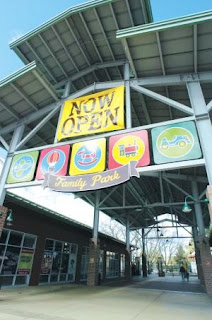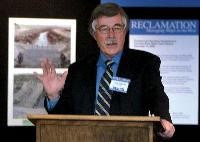Genentech expands cell-culture plant; Kaiser builds 142-bed hospital
East Bay Business Times - February 23, 2007
by Jessica Saunders

The Genentech campus in Vacaville, when completed by 2009, will be the world’s largest cell-culture biotech plant. The first phase of the project opened in 1998.
Once best known for the Nut Tree and outlet stores, Vacaville is developing a new identity - as a biotech center.
The city owes its new identity to Genentech Inc., which is creating the world's largest cell-culture biotechnology manufacturing plant, a $1.2 billion, 807,000-square-foot facility with a production capacity of 344,000 liters. The facility, located at Vaca Valley Business Park, will be completed by 2009.
Vacaville, the northern Solano County town of 96,395, began its evolution when Genentech, the global biotechnology leader and maker of cancer treatments such as Herceptin, Avastin and Rituxan, opened a production facility there in 1998. Now the city is among locations worldwide considered for new drug plants. "In the world of biotech manufacturing we are a place to be looked at," said Mike Palombo, the city's economic development manager.
And it's not just biotechnology that's growing in Vacaville. In the same area - the so-called "triangle" formed by the intersection of interstates 80 and 505 - Kaiser Permanente is building a 142-bed hospital and a second medical office building, and the State Compensation Insurance Fund has broken ground for a five-building, 434,375-square-foot office complex that will be the city's largest. The new Nut Tree shopping center is open, Solano Community College wants to expand its Vacaville campus, and hundreds of new homes are under construction.
Many factors drive boom
What's driving the boom is the relatively cheap cost of land, affordable housing, a skilled labor force and proximity to the Bay Area. Commercial real estate experts also point to relatively short commute times and low unemployment and crime rates.
In a crowded field of commercial development in Vacaville, Genentech's 380,000-square-foot expansion of its manufacturing facility, which already looms along Interstate 505, is the clear standout. The project, announced in April 2004, was begun to meet a growing demand for existing and future drugs. Genentech chose to expand in Vacaville to leverage the staff and assets already there, and because its strong relationships with state and local governments gave it a "significant timing advantage for increasing our production," according to an e-mail from a company spokesperson.
The new plant, CCP2 (cell culture plant two), will house eight bioreactors, each with a 25,000-liter capacity, which is about double the typical bioreactor size and the largest in the industry. Contractors used three-dimensional computer modeling to plan how to ship the outsized, highly polished stainless-steel tanks and get them into place, said Steve Zoeller, principal project manager, project engineering. The plant is also "base-isolated," so it will roll during earthquakes.
The expansion adds 200,000 liters of capacity to the 144,000 liters produced by the existing CCP1, a 427,000-square-foot plant that opened in 1998 and was licensed by the U.S. Food and Drug Administration in May 2000. According to industry research by Genentech, the total 344,000 liters that will be available upon licensing of CCP2 makes the Vacaville plant "by far" the largest facility of this type in the world, said Frank Jackson, vice president and general manager of Vacaville operations for Genentech. The next closest is an Amgen Inc. plant in Rhode Island.
The expansion will add about 575 employees to the more than 700 on-site as of November 2006.
The construction project - led by DPR Construction Inc. and involving 120 companies, contractors and vendors - has taken 1,300 workers 3.1 million work hours, required 2,800 truckloads of concrete and 12,000 tons of steel, and included the installation of 13,000 instruments.
"It is an incredibly complex facility, and it has to be because of the requirements of the process," said Karen Brockwell, CCP2 client team leader.
The plant will produce bulk liquid drugs that are shipped to another site for portioning into individual doses, packaging and labeling. In addition to Avastin, Herceptin and Rituxan, the Vacaville plant also produces Xolair for asthma patients, with production varying each year.
Construction of CCP2 is expected to be completed in June, about three years since ground was broken in the third quarter of 2004. After that, the company begins the roughly 24-month licensing process.
Prior to licensing, manufacturing facilities undergo periods of startup and validation. The plant will produce qualification batches of product and then submit an FDA filing for licensure. Company officials said they expect the facility to be licensed in the second half of 2009.
Kaiser building hospital
Less than a mile away, Kaiser Permanente is working on a 142-bed hospital with an emergency department, maternity services and all private rooms, scheduled to open in April 2009, along with a second medical office building due to open in late 2008, according to Senior Vice President Deborah Romer, Kaiser Permanente's area manager for Napa and Solano counties. The expansion is expected to add 1,500 jobs.
Kaiser membership in the two-county area is at 250,000 people and continuing to grow, with Vacaville and Fairfield representing the fastest-growing cities within that region. Romer said Kaiser estimates the new hospital will serve 50 percent of its membership in Napa and Solano counties.
The growth in membership includes many young families, so maternity services are an important aspect of the expansion, she said.
The new office building will provide space for up to 60 specialists in services that include gastroenterology, orthopedics, cardiology and general surgery, along with an ambulatory surgery center. The existing office building, which opened in 1996, houses primary-care services such as pediatrics; obstetrics and gynecology; occupational health and mental health; and ear, nose and throat surgery.
Hospitals designed by template
Vacaville is one of four areas where Kaiser is building new hospitals. The others are Antioch, Modesto and Irvine. All were built using a template design - a common set of architectural features customized to reflect each facility's square footage and number of beds - thus saving months in the approval process by the Office of Statewide Health Planning and Development, Romer said.
Partly because of the success of the template project, Kaiser is considering establishing a common design for all its new hospitals. In addition to saving time, it would allow for a common "identity and experience" for hospital patients and visitors, Romer said. "We are looking at that much more closely."
Another project, the State Compensation Insurance Fund's first phase of its five-building complex, located between Kaiser and Genentech on a 32-acre site in Vaca Valley Business Park, is expected eventually to house 1,200 employees.
The nonprofit workers' compensation insurer in 2005 decided against expanding its headquarters in San Francisco and instead chose to build the new space it needed on cheaper land in Vacaville, spokesman Jim Zelinksi said. Its headquarters remain in San Francisco.
The first phase of the campus, three two-story buildings, is expected to be completed in 2008. The remaining buildings, also two stories tall, will be added by 2011. Among the functions to be housed at the site is State Compensation Insurance Fund's information technology division, including a data center for the secure storage of insurance information for 223,000 policyholders.
All the expansion in the area hasn't been lost on one of the Bay Area's biggest home builders. Concord-based Albert D. Seeno Construction Inc. is building 2,000 homes and apartments in the 880-acre North Village development, across Vaca Valley Parkway from Kaiser, State Fund and Genentech. It's expected to reach build-out in 10 years.

A Genentech employee, below, works inside the facility.
Genentech Inc.
NYSE: DNA
Business: Biotechnology company
Headquarters: South San Francisco
Founded: 1975
Chairman & CEO: Arthur D. Levinson
Employees: 9,500
2006 Operating Revenue: $9.3 billion
2006 U.S. Product Sales: $7.2 billion
Address: 1 DNA Way, South San Francisco 94080
Phone: 650-225-1000
Web: www.gene.com
Kaiser Permanente
Business: Private nonprofit health care provider
Headquarters: Oakland
Founded: 1945
Chairman & CEO: George C. Halvorson
Employees: 148,884
Address: 1 Kaiser Plaza, Oakland 94612
Phone: 510-271-5800
Web: www.kaiserpermanente.org
State Compensation Insurance Fund
Business: Nonprofit workers' compensation insurer
Headquarters: San Francisco
Founded: 1914
President: J.C. Tudor
Employees: 10,500
2005 Assets: $21.6 million
Address: 1275 Market St., San Francisco 94103
Phone: 415-565-1234
Web: www.scif.com
jsaunders@bizjournals.com | 925-598-1427



